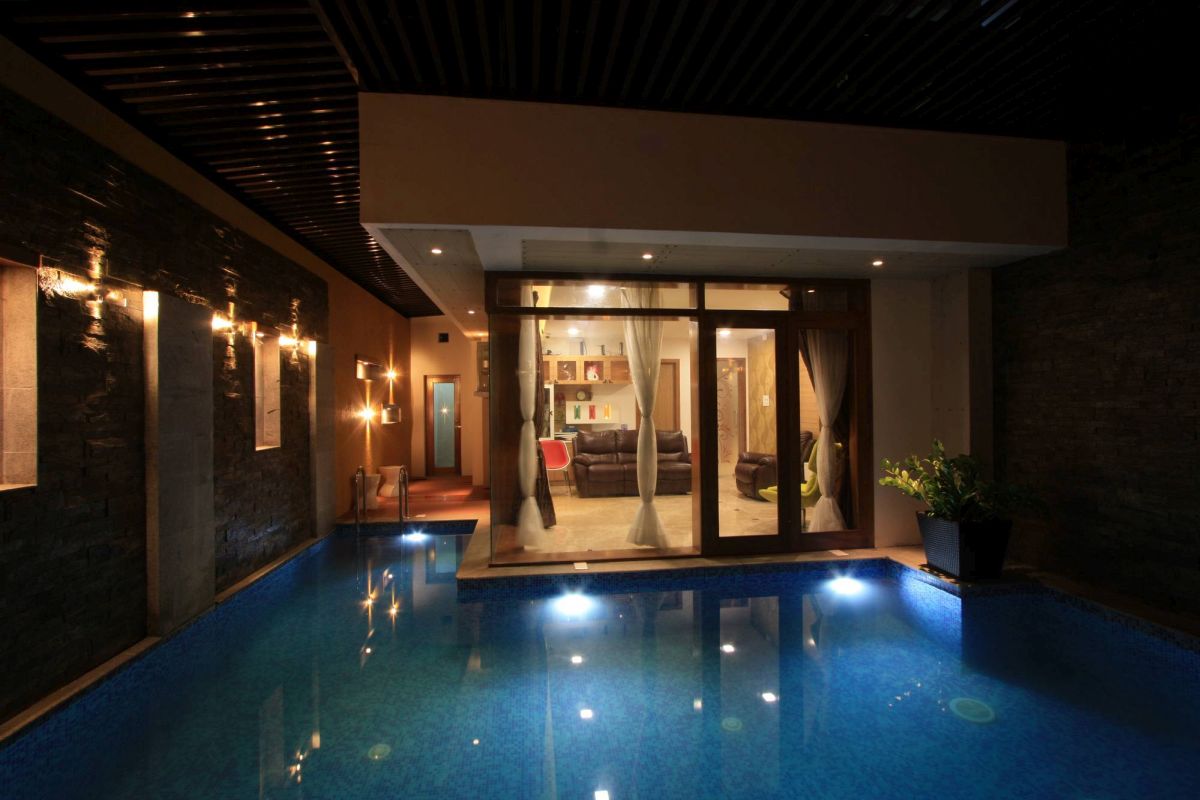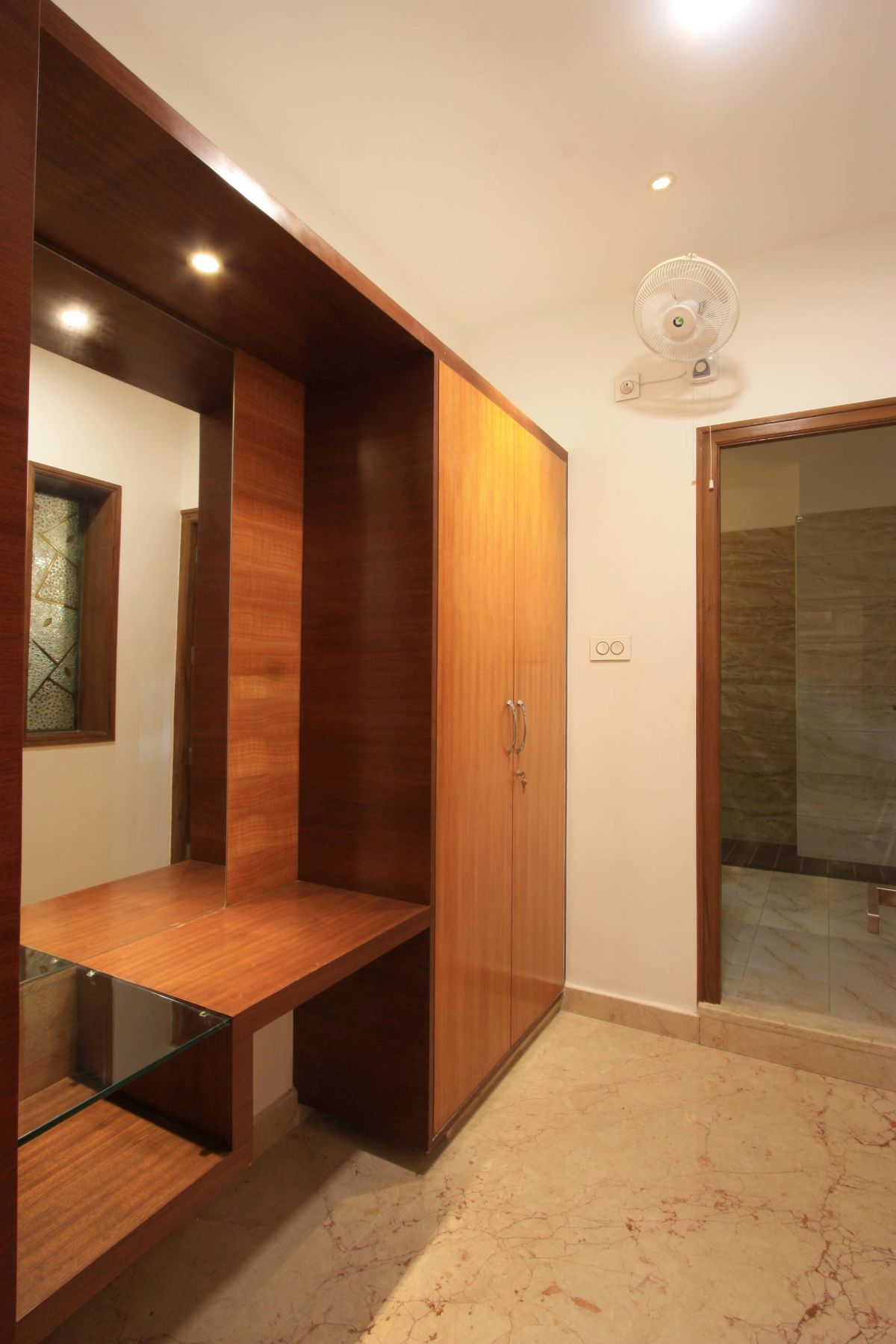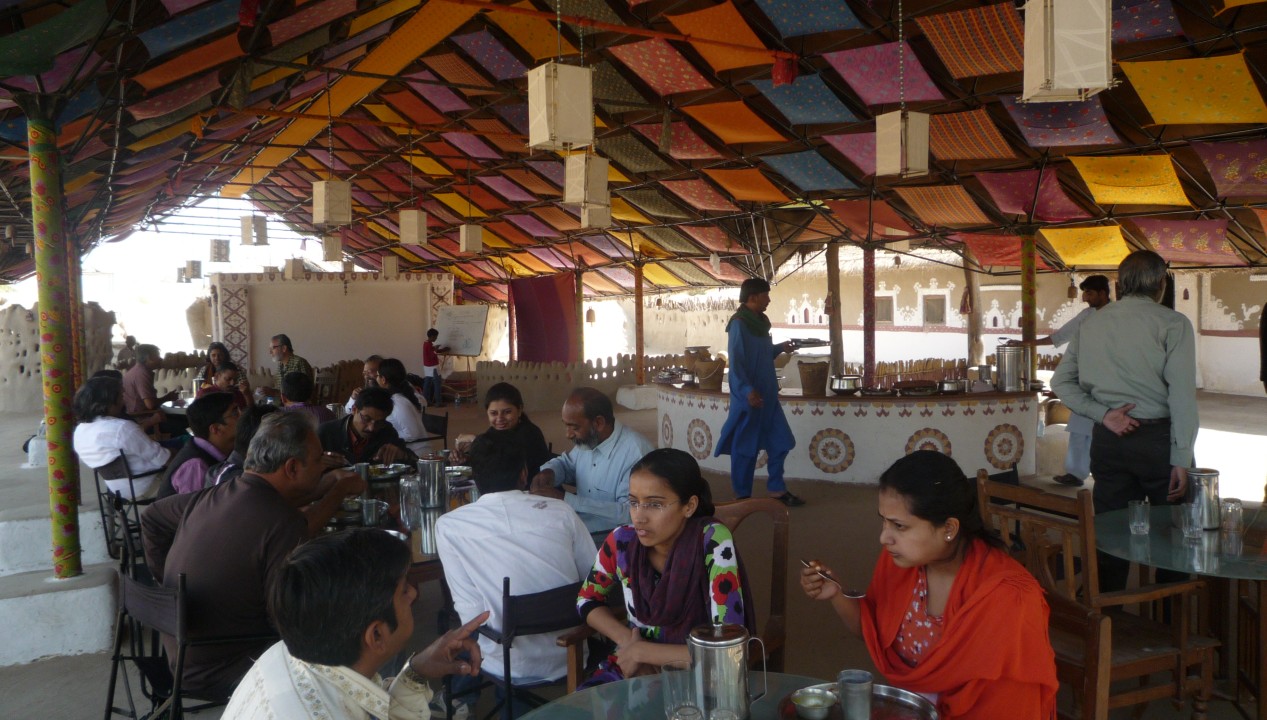This west facing house has been designed in such a way that the amount of sunlight and heat is reduced by pergolas at different levels thus improving the micro climate inside the house and its surrounding. The pergolas are specifically designed with geometric cut outs for aesthetic look as well as to avoid the large pergolas from looking too heavy. Utility areas like the toilets and balconies placed on the Western side as buffer zones to guard against the heat.
Projections of balconies, horizontal planes and recessed surfaces come together to form a facade with a unique character. This coupled with pergolas placed over landscaped courtyards create an interesting play of light and shadow in the midday Sun. Terrace area in front has been uniquely designed into a large garden space below the pergolas. Interiors of the house give a contemporary look with its sleek and minimalistic furniture and simple false ceilings. We aimed to create climatic comfort with luxury in this residence with uniquely interesting materials and intelligent use of spaces.
Courtyards were planned in the interior of the house bring in abundant natural light and greenery into the the house. Being in any part of the house, one is subtly reminded of the nature of the place and its changing character throughout the day presented through Sunlight playing in the strategically placed courtyards. The design becomes more about experiences than the form alone.
BRIEF GIVEN BY THE CLIENT BEFORE THE PROJECT IS STARTED
The client’s requirements were put together with the inputs from Chief architect, discussed and framed as following. Living, Dining, Kitchen, Bedrooms with Walk-in-wardrobes, Dress and Toilets, all of high end luxury standards in addition Family, Drawing room, Lumber room, Store Room, Lounge, Prayer Room and space for Security and Garage, area for Service along the kitchen.
The major challenge on the architect’s side was to solve the climatic restrictions, and to bring in more of natural light and ventilation into the house. By not only giving a lot of open spaces like Courtyards, Sit outs, Verandahs, Wooden Deck, Semi Open Terrace, Lawn and Swimming Pool but also by allocating each of these open spaces in right positions to achieve the goal of minimum usage of electricity and artificial lighting. Thus this house can be called as as a climatically sustainable design.
INITIAL THOUGHT PROCESS BEFORE FINALIZING THE DESIGN OF THE PROJECT
The site being located on the Tropical Hot and Humid Climatic Zone in South of Chennai and the prominent side of the site facing West, the Climatic Conditions were to be analyzed and considered as a major factor at the initial stage of Designing, Zoning, Schematic Layouts and Massing.
The major thought process or may be the challenge on the architect’s side was to solve the climatic hindrances and bring in more of natural light and natural ventilation into the house. By not only giving a lot of open spaces like Courtyards, Sit outs, Verandahs, Wooden Deck, Semi Open Terrace, Lawn and Swimming Pool and also by allocating each of these open spaces in right position to achieve the goal of minimum usage of electricity and artificial lighting.
While achieve requirements in satisfying the Spacial Planning through proper Zoning and Circulation without compromising on Massing Structure.
THE ARCHITECTURAL FEATURES OF THE PROJECT AND THE GEOMETRICS OF THE PROJECT
The side of the site facing the road falls on the West which is the most hottest zone. Hence the House was designed in such a way that the amount of sunlight and heat is reduced giving micro climatic change. The Pergolas at two different levels, both with Geometric cut outs give a lighter feel to them, partially covers the terrace and provides ample shade to terrace and the inner space by cutting hot sunlight and allowing only diffused sunlight into the space. The semi covered landscaped terrace in the first floor has been designed as a large garden area below the shades of two levels of pergolas. These two levels of pergolas help to keep the terrace cool, thus there is a very less reflected heat into the room facing this terrace.
Courtyards planned in living and dining area of the house makes the indoors space connected to the outdoors with the advantage of drawing cool breeze and abundant natural light. This unrestricted light and controlled temperature gives required climatic comfort within the building. Water body in the front is introduced into the house as thermal regulators through which deflected and cool wind is passed into the house and it also doubles as a swimming pool. Areas like the toilets and balconies is placed on the western side acts as buffer zones to guard against the heat ingress, thus creating a comfortable micro climate inside while reducing the energy expenditure.
Projections of balconies, planes, fin walls and recessed surfaces come together to carve out a facades with a unique character. These coupled with pergolas placed over landscaped courtyards create a play of light and shadow.
The Exterior Massing Structure is treated with only two color and texture combination the White Paint Finish for the Horizontal slab projections and Rustic Stone Finish for Vertical Fin Walls added with Glass Canopy and Glass Railing. Giving a minimalist Design.
Interiors of the house give a contemporary look with its sleek and simple furniture and false ceiling design blends with the furniture for a luxury feel. Different textures are created in the finishes with the use of glass, wood, stone and wall paper in different rooms to match with different personalities of the occupants. A soft pallet of colours scheme dominates the main area of the house enabling a liberated and spacious feel. Hand picked wall hanging, curios, artifacts and other loose furniture create focal points and highlight the interiors. We aimed to create comfort with interesting materials and aesthetic use of spaces.
Living and dining areas are divided with a partition cum display unit which acts as a focal point in this large area. Free flowing and large family room in the first floor has false ceiling and furniture that gives an open and spacious feel. Being in any part of the house, one is subtly reminded of the nature of the place and its changing character. The design becomes more about experience than the form alone.
THE CLIMATIC DESIGN ASPECTS OF THE PROJECT
Understanding the site location at South Tamil Nadu, which is in the Tropical Warm and Humid Climatic Zone, with the prominent side of the site facing West, the major cafeterias to be taken into consideration and satisfied from Architect’s side was to take the first step on the site analysis and make hematological study of the site. The challenge on the architect’s side was to solve the climatic hindrances and bring in more of natural light and natural ventilation into the house, by reducing usage of electricity and artificial ventilation.
Giving more open spaces like Courtyards, Sit outs, Verandahs, Wooden Deck, Semi Open Terrace, Lawn and Swimming Pool and also by allocating each of these open spaces in right position to achieve the goal of minimum usage of electricity and artificial lighting. Due to the site conditions in terms of its location, there required a large shading device. Shading devices generally cuts the direct sunlight getting into the room space partially and makes it a diffused sunlight, producing a cool zone.
Hence the Pergolas are designed at two different levels, both with Geometric cut outs gives a lighter feel and partially covers the terrace, providing ample shade to terrace and the inner space by cutting hot sunlight and allowing only diffused sunlight into the space.
Courtyards are the spaces which brings in a feel of experiencing the outside with in inside. The Courtyards are planned in living and dining area of the house makes the indoors space connected to the outdoors with the advantage of drawing cool breeze and abundant natural light. This unrestricted diffused light and controlled temperature gives required climatic comfort within the building. Water body in the front is introduced into the house acts as thermal regulators through which deflected and cool wind is passed into the house and it also doubles as a swimming pool. Being in any part of the house, one could be reminded of the nature of the place and its changing character. The design becomes more about experience than the form alone.
OVERALL EXPERIENCE
The people worked on this project had an overall experience on Climatic Analysis and study on various climatic stratergies which could be implemented in a building structure. The time Duration from Designing stage till the completion of the project including interiors and exterior finishes is 2 years.






































































